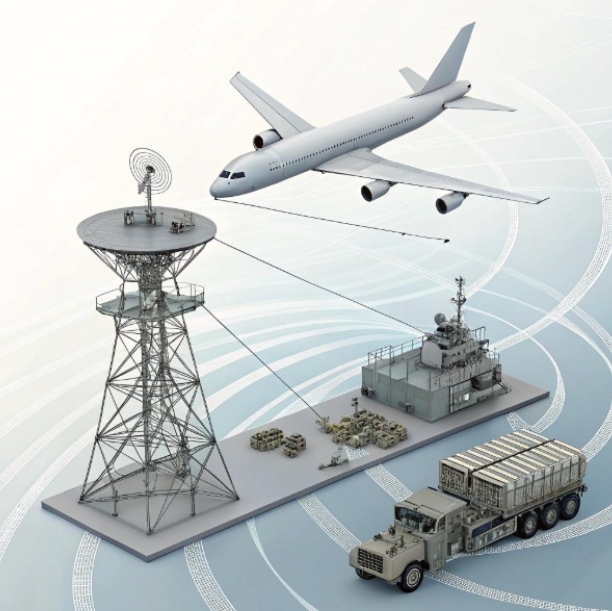Business Solutions
Why AI Tops Factory Automation for Modern Manufacturing
Published
5 months agoon
By
Dev Dev
AI tops the list of transformative technologies reshaping factory automation. Factory automation AI enables unprecedented levels of efficiency, precision, and flexibility, empowering manufacturers to streamline operations, enhance quality control, and optimize production processes. As factories adopt AI-driven automation, they are achieving new levels of productivity, reducing downtime, and positioning themselves to meet the demands of an increasingly digital and data-driven world.
How AI Enhances Efficiency in Factory Automation
One of the most significant contributions of AI in factory automation is its ability to enhance efficiency on the production floor. By analyzing large volumes of data in real time, AI can monitor machine performance, optimize workflow, and predict potential issues before they disrupt production. This predictive capability enables manufacturers to reduce idle time, identify bottlenecks, and ensure smooth operations across the factory.
AI also assists in automating repetitive tasks, freeing up workers to focus on more complex activities that require human intelligence. For instance, AI-driven robotic arms can sort, assemble, and package products with remarkable speed and accuracy, enabling manufacturers to increase output without sacrificing quality. In addition, AI algorithms can adjust production schedules based on real-time data, enabling manufacturers to meet changing demand efficiently.
By automating resource allocation and streamlining processes, factory automation AI helps companies save on operational costs. With AI optimizing everything from energy usage to inventory management, manufacturers can significantly reduce waste and operate more sustainably, which is essential for both environmental and economic reasons.

Predictive Maintenance: Preventing Downtime with AI
One of the most valuable applications of factory automation AI is predictive maintenance. Downtime can be incredibly costly for manufacturers, leading to lost production, missed deadlines, and increased maintenance costs. AI helps to address this issue by predicting equipment failures before they occur, allowing for timely repairs and maintenance.
By continuously monitoring machine data such as temperature, vibration, and wear, AI can identify early warning signs of equipment issues. This proactive approach means maintenance can be scheduled at convenient times, preventing unplanned outages. Predictive maintenance also reduces the frequency of routine maintenance, as equipment is only serviced when necessary, based on real-time data rather than a fixed schedule.
Implementing predictive maintenance with AI not only minimizes downtime but also extends the lifespan of equipment. By avoiding unnecessary strain on machinery, manufacturers can reduce their capital expenditures on replacements and achieve a better return on investment for their assets.
AI-Powered Quality Control in Manufacturing
Quality control is another area where AI tops traditional methods, offering a more accurate and efficient approach to detecting defects. In the past, quality control relied heavily on manual inspection, which could be slow and prone to human error. Factory automation AI enhances quality control by leveraging machine vision and advanced algorithms to inspect products for defects in real-time.
AI-powered cameras and sensors capture images and data from every product that passes through the production line. Machine learning algorithms then analyze this data, identifying even the smallest imperfections that might be missed by the human eye. By detecting defects early, manufacturers can take corrective actions immediately, preventing flawed products from reaching customers and reducing waste.
This AI-driven approach to quality control also helps manufacturers maintain consistency in their products. By analyzing patterns and trends, AI systems can optimize production processes to ensure uniformity and adherence to quality standards, providing customers with reliable and high-quality products.
Robotics and AI Integration for Smarter Automation
The integration of robotics and AI has been a game-changer in factory automation, enabling manufacturers to achieve levels of speed and precision that were previously unattainable. Robotics alone can handle repetitive tasks, but when combined with AI, they can adapt to new tasks, identify objects, and make decisions based on real-time data.
AI-enhanced robots can work alongside human workers, handling tasks that may be too dangerous, tedious, or complex for people. For example, in automotive manufacturing, AI-driven robots can assemble parts, weld, and even paint with precision, ensuring high standards while reducing safety risks for human workers. Collaborative robots, or “cobots,” use AI to learn from their human counterparts, enabling them to perform tasks with greater efficiency and flexibility.
The use of robotics powered by factory automation AI is helping manufacturers increase output while maintaining a high degree of accuracy, reducing production errors, and improving overall productivity.
Data-Driven Decision Making with AI Tops in Factories
In the age of data, manufacturers need the ability to make fast, data-driven decisions. AI tops the list of tools that enable this, by processing massive amounts of data from production lines, supply chains, and customer feedback to provide actionable insights. Factory automation AI can identify trends, analyze performance metrics, and even predict outcomes, giving managers the information they need to make strategic decisions with confidence.
For example, AI can analyze production data to determine the most efficient workflow for a specific product, helping managers optimize their operations. Additionally, AI systems can predict demand based on historical data and market trends, enabling factories to adjust production levels accordingly. This capability helps manufacturers avoid overproduction or underproduction, which can lead to excess inventory or missed sales opportunities.
With AI at the core of decision-making, manufacturers can respond quickly to market changes, improve resource allocation, and maintain a competitive edge.
The Role of AI in Supply Chain Optimization
AI in factory automation extends beyond the production floor, significantly impacting the supply chain as well. By analyzing data from suppliers, inventory levels, and demand forecasts, AI helps optimize the supply chain, ensuring that materials and components are available when needed without overstocking.
Factory automation AI can predict demand fluctuations and adjust orders accordingly, helping manufacturers maintain lean inventory levels while avoiding shortages. This improves cash flow, reduces waste, and enhances operational efficiency. In addition, AI can identify reliable suppliers and assess risks, making it easier to manage relationships and ensure a steady flow of resources.
With AI optimizing the supply chain, manufacturers can meet production deadlines, reduce lead times, and maintain customer satisfaction by delivering products on time.
Safety and Risk Management with AI in Factories
Worker safety is a top priority in any manufacturing environment, and factory automation AI is playing an essential role in enhancing safety and managing risks. AI can monitor work environments in real-time, identifying potential hazards and ensuring that safety protocols are followed. By analyzing sensor data, AI systems can detect unsafe conditions, such as equipment malfunctions or extreme temperatures, and alert workers before accidents occur.
In addition to monitoring the environment, AI-powered systems can track worker behavior, ensuring compliance with safety standards and identifying areas where further training might be needed. For tasks involving heavy machinery or hazardous materials, AI can automate or assist with handling, reducing the risk to workers.
With AI-driven safety measures, factories can improve workplace conditions, minimize accidents, and create a safer environment for employees.
FAQs on AI Tops in Factory Automation
- How does AI improve efficiency in factory automation?
AI optimizes processes by analyzing data in real-time, reducing downtime, and automating repetitive tasks, which streamlines operations. - What is predictive maintenance, and how does AI help?
Predictive maintenance uses AI to detect early signs of equipment issues, allowing timely repairs and preventing unexpected breakdowns. - How does AI-powered quality control work?
AI uses machine vision to inspect products for defects in real-time, ensuring high-quality output and reducing waste. - What role do robots play in AI-driven factory automation?
AI enhances robotics, enabling smarter, adaptable robots that handle complex tasks and work alongside humans. - How does factory automation AI support decision-making?
AI processes large amounts of data, providing insights that help managers make data-driven decisions to optimize operations.
Years of covering technology and startup news.

You may like
Business Solutions
IEEE 802.11p and V2X Communication: Enabling Smarter, Safer Roads
IEEE 802.11p revolutionizes V2X communication, driving smarter, safer roads through advanced vehicle connectivity. This cutting-edge technology enhances transportation systems, enabling intelligent and secure interactions for a safer future.
Published
16 hours agoon
May 7, 2025By
Adva
Modern vehicles are no longer isolated machines; they are becoming intelligent, connected nodes within a larger transportation ecosystem. At the heart of this transformation is Vehicle-to-Everything (V2X) communication, which enables cars to talk to each other and to the infrastructure around them. One of the first and most influential technologies developed to support V2X is the IEEE 802.11p standard—a wireless standard specifically tailored for vehicular environments.
What is IEEE 802.11p?
IEEE 802.11p is an amendment to the IEEE 802.11 standard (commonly known as Wi-Fi), designed to enable wireless access in vehicular environments. It was approved in 2010 and forms the basis for Dedicated Short-Range Communications (DSRC).
Key Characteristics of 802.11p:
- Frequency Band: Operates in the 5.9 GHz band reserved for Intelligent Transportation Systems (ITS).
- Low Latency: Optimized for fast, real-time communication necessary for safety-critical applications.
- Range: Effective communication range of up to 1 kilometer, suitable for high-speed vehicle interaction.
- Decentralized Architecture: Enables direct communication (V2V and V2I) without the need for cellular or network infrastructure.
- Robustness: Handles high-speed mobility and rapidly changing topologies typical of vehicular environments.

Role of 802.11p in V2X Communication
V2X (Vehicle-to-Everything) is a broader term encompassing various communication paradigms, including:
- V2V (Vehicle-to-Vehicle)
- V2I (Vehicle-to-Infrastructure)
- V2P (Vehicle-to-Pedestrian)
- V2N (Vehicle-to-Network)
- V2C (Vehicle-to-Cloud)
802.11p primarily supports V2V and V2I communications, forming the backbone of DSRC-based V2X implementations. Its low latency and direct communication capabilities make it ideal for applications such as:
- Forward collision warnings
- Intersection movement assist
- Emergency electronic brake lights
- Lane change warnings
Comparison with Cellular V2X (C-V2X)
As V2X technology has evolved, C-V2X (based on LTE and 5G standards) has emerged as a strong alternative to 802.11p. Here’s how they compare:
| Feature | IEEE 802.11p (DSRC) | C-V2X (LTE/5G) |
| Latency | ~10 ms | ~5–10 ms (LTE), <5 ms (5G) |
| Coverage | Short-range, direct | Short + long-range via network |
| Deployment | Mature, field-tested | Growing, especially with 5G |
| Infrastructure | Minimal (no cellular needed) | Requires cellular networks (for V2N/V2C) |
| Interoperability | Limited with C-V2X | Newer versions support dual-mode |
Adoption and Use Cases
Global Deployment:
- United States: Initially favored DSRC based on 802.11p, though recent FCC rulings have shifted focus toward C-V2X.
- Europe: ETSI has defined ITS-G5, a protocol stack based on 802.11p.
- Japan and South Korea: Active use of DSRC for tolling and traffic safety.
Real-World Applications:
- Collision avoidance systems
- Smart intersections
- Road hazard notifications
- Platooning for commercial vehicles
- Public transport priority systems
Advantages of 802.11p
- Mature and Proven: Used in numerous pilot programs and early deployments.
- Fast Time to Communication: No need for handshake protocols; devices can communicate almost instantly.
- No Subscription Costs: Operates independently of cellular networks.
Limitations and Challenges
- Scalability: In high-density traffic, packet collisions may reduce reliability.
- Spectrum Allocation: Regulatory changes in some countries have limited the bandwidth available to DSRC.
- Limited Ecosystem Growth: Many automakers and countries are shifting investment to C-V2X and 5G-based platforms.
Future Outlook
While 802.11p has laid the foundation for V2X communication, the industry is gradually pivoting toward more advanced and scalable technologies such as 5G NR-V2X. However, 802.11p remains relevant in regions where DSRC infrastructure is already deployed and continues to serve as a dependable option for immediate, low-latency vehicular communication.
Hybrid Solutions:
Some industry players are exploring dual-mode V2X devices that support both 802.11p and C-V2X, ensuring backward compatibility and smoother transitions.
IEEE 802.11p has played a pivotal role in launching the era of connected vehicles, offering reliable, low-latency communication tailored for high-speed mobility. While newer technologies like C-V2X and 5G are beginning to dominate the roadmap, 802.11p’s contributions remain foundational in the evolution of V2X systems. As the automotive industry moves forward, a mix of technologies, including legacy support for 802.11p, will ensure that safety, efficiency, and connectivity continue to advance on roads around the world.
Business Solutions
Turning Up the Heat on Aging: Understanding Radio Frequency Skin Tightening
Discover how Radio Frequency Skin Tightening is revolutionizing non-invasive anti-aging treatments. This guide breaks down how RF technology works, its benefits for reducing wrinkles and firming skin, and why it’s becoming a go-to solution for those looking to rejuvenate their appearance without surgery.
Published
2 weeks agoon
April 24, 2025By
Adva
In the ongoing quest for youthful and rejuvenated skin, a variety of non-surgical medical aesthetic devices and technologies have emerged, each promising to turn back the clock. Among these, Radio Frequency (RF) skin tightening has gained significant popularity for its ability to address skin laxity, wrinkles, and overall skin texture without the need for invasive procedures or lengthy downtime.
How Radio Frequency Works its Magic:
Radio frequency skin tightening utilizes electromagnetic waves to deliver controlled heat deep into the skin’s layers, specifically the dermis. This targeted thermal energy triggers a cascade of beneficial responses within the skin:
Collagen Contraction: The heat causes existing collagen fibers to contract and tighten, providing an immediate firming effect. Think of it like shrinking a loose sweater.
Collagen Stimulation: More importantly, the controlled thermal injury stimulates fibroblasts, the cells responsible for producing collagen and elastin. This prompts the generation of new, healthy collagen fibers over time, leading to long-term improvement in skin elasticity and firmness.
Improved Circulation: The heating effect also enhances blood circulation in the treated area, bringing more oxygen and nutrients to the skin cells, further contributing to a healthier and more vibrant complexion.
The Benefits of RF Skin Tightening:
The appeal of radio frequency technology lies in its ability to deliver noticeable results with minimal disruption to daily life. Key benefits include:
Non-Invasive: Unlike surgical facelifts, RF treatments require no incisions, stitches, or anesthesia, making them a comfortable and convenient option.
Skin Tightening and Firming: The primary benefit is the visible tightening of loose or sagging skin on the face, neck, and body. This can improve the appearance of jowls, brow lines, and loose skin on the abdomen and arms.
Wrinkle and Fine Line Reduction: By stimulating collagen production, RF can help to smooth out fine lines and wrinkles, resulting in a more youthful appearance.
Improved Skin Texture and Tone: The treatment can enhance overall skin texture, making it smoother and more even-toned. It can also help to minimize the appearance of sun damage and enlarged pores.
Gradual and Natural-Looking Results: The improvements from RF treatments are typically gradual, appearing over several weeks and months as new collagen is produced, leading to a natural-looking rejuvenation.
Minimal Downtime: Most individuals experience little to no downtime after an RF session and can typically return to their normal activities immediately.
Versatility: RF technology can be used to treat various areas of the face and body, including the forehead, cheeks, jawline, neck, décolletage, abdomen, arms, and thighs.
Suitable for Most Skin Types: Generally, RF treatments are considered safe for a wide range of skin types and tones.

What to Expect During an RF Treatment:
A typical RF skin tightening session involves the following:
Preparation: The skin in the treatment area is cleansed, and a conductive gel is applied to help the RF device glide smoothly and ensure efficient energy delivery.
Treatment: A handheld RF device is moved over the targeted areas. You may feel a warming sensation, which is generally well-tolerated. Some devices incorporate cooling mechanisms to enhance comfort.
Post-Treatment: After the session, the gel is removed, and a soothing lotion or sunscreen may be applied.
The duration of a treatment session can vary depending on the size of the area being treated, typically ranging from 30 to 60 minutes. A series of treatments is usually recommended to achieve optimal and long-lasting results, with sessions spaced a few weeks apart. Maintenance treatments may also be advised to sustain the benefits over time.
Potential Side Effects and Considerations:
While RF skin tightening is generally considered safe, some mild and temporary side effects may occur, including:
Redness: The treated area may appear flushed or red immediately after the procedure, which usually subsides within a few hours to a day.
Swelling: Mild swelling or puffiness can occur but typically resolves within a day or two.
Warmth or Tingling: A lingering sensation of warmth or tingling in the treated area is common and usually temporary.
Dryness: Some individuals may experience temporary skin dryness.
More serious side effects are rare when the procedure is performed by a qualified and experienced professional using FDA-approved devices. However, potential risks can include burns, blistering, or temporary changes in skin pigmentation, particularly if the treatment is not administered correctly.
Choosing the Right Provider:
To ensure a safe and effective RF skin tightening experience, it is crucial to choose a reputable clinic and a qualified practitioner with specific training and experience in this technology. During your consultation, discuss your skin concerns, medical history, and expectations to determine if RF skin tightening is the right option for you.
Radio frequency skin tightening technology offers a promising non-surgical solution for those seeking to combat the signs of aging and achieve firmer, smoother, and more youthful-looking skin. By harnessing the power of controlled thermal energy to stimulate collagen production and tighten existing fibers, RF treatments provide a gradual and natural-looking rejuvenation with minimal downtime. While generally safe, it’s essential to understand the potential side effects and choose a qualified provider to maximize benefits and minimize risks on your journey to radiant skin.
Business Solutions
Mil-Aero RF Applications Power Up With 5G DAS
The integration of 5G DAS is propelling Mil-Aero RF Applications into a new era of efficiency and reliability. By delivering unmatched connectivity and advanced communication capabilities, 5G DAS enhances the precision and performance of military and aerospace RF technologies. This innovation is streamlining operations, improving data transmission, and paving the way for smarter, faster solutions in critical industries. Explore how 5G DAS is revolutionizing the future of defense and aerospace communication systems.
Published
2 weeks agoon
April 22, 2025By
Adva
The 5G DAS Boom in Aerospace and Defense
As 5G standards continue to evolve and new spectrum (like mmWave and sub-THz) becomes accessible, the potential for 5G DAS in Mil-Aero RF applications is expanding. Future systems will likely incorporate beamforming, AI-defined networking, and autonomous RF management.
The distributed antenna system (DAS) model, once reserved for stadiums and city centers, has now found a new frontier—military and aerospace environments. With the exponential demand for bandwidth, low latency, and secure communication, 5G DAS is being adopted by armed forces and aerospace manufacturers to meet unprecedented performance requirements.
Defense facilities, aircraft hangars, and command centers are increasingly turning to DAS to extend high-speed, reliable 5G coverage indoors and across large areas. Traditional signal architectures simply can’t keep up with the data throughput and latency expectations of modern RF-driven systems.
Integrating 5G DAS allows defense leaders to future-proof their communications infrastructure—meeting today’s demands while preparing for tomorrow’s threats.
Understanding Mil-Aero RF Requirements
In the Mil-Aero space, RF isn’t just about connectivity—it’s about survivability, accuracy, and split-second decisions. Unlike commercial settings, where a dropped signal is annoying, failure in a military context can be catastrophic.
RF systems in this space must endure electromagnetic interference, extreme temperatures, high G-forces, and prolonged operations under hostile conditions. Whether it’s radar systems on a fighter jet or data links on an unmanned aerial vehicle, the RF infrastructure must be robust, shielded, and deeply reliable.
Precision timing, spectral purity, and resilience against jamming or spoofing are not optional—they are baseline standards. And 5G DAS brings the flexibility to meet those standards while enabling dynamic scaling and multi-mission adaptability.
The Shift from Legacy Systems to 5G DAS
Legacy radio networks have long served the defense community, but their limitations are now glaring. Fixed infrastructure can’t adapt to rapid deployment. Narrowband systems can’t support AI-powered drones or satellite uplinks. And analog RF paths can’t deliver the latency-sensitive data modern forces rely on.
5G DAS provides an answer. With its scalable, modular design, DAS can be tailored to both temporary forward-operating bases and permanent installations. It enables hybrid architectures that mix fiber, coax, and wireless links while managing them from a unified platform.
The shift isn’t just about replacing equipment—it’s about reimagining the RF ecosystem with agility in mind.

Secure Communications in Classified Environments
One of the major concerns in Mil-Aero deployments is securing the communication channels that carry classified or mission-sensitive information. Encrypted radios and private mobile networks help, but physical infrastructure like DAS must also meet security specifications.
5G DAS systems used in defense zones are typically deployed with end-to-end encryption, tamper detection, and electromagnetic shielding to protect signal integrity. They can be designed to support air-gapped networks and operate on isolated frequency bands, ensuring zero bleed into unauthorized zones.
Additionally, user authentication and device management are tightly controlled via mobile device management (MDM) protocols, ensuring every node connected to the DAS is accounted for and authorized.
Low Latency and High Reliability in Mission-Critical Ops
Time is a luxury in the theater of operations. Whether coordinating UAVs mid-flight or transmitting reconnaissance data from a remote desert location, latency is the enemy. The reduced latency provided by 5G DAS allows for near-instantaneous communication, even in complex mesh environments.
Unlike traditional RF relay systems, DAS can distribute the signal over multiple antennas with centralized intelligence. This means data doesn’t have to travel long distances to a base station before being routed—it can move through a local edge network in microseconds.
Reliability is equally important. With automatic failover, load balancing, and real-time monitoring, DAS systems reduce single points of failure and keep operations running even when components are damaged or degraded.
Distributed Antenna Systems for Airborne and Ground Units
Deploying communication infrastructure in environments that are always moving, like helicopters, naval vessels, or mobile command vehicles, requires a new kind of system design. This is where DAS demonstrates unmatched versatility.
In airborne platforms, DAS nodes can be mounted in vibration-isolated modules, providing consistent coverage throughout the aircraft. For ground vehicles, compact DAS units enable low-profile signal distribution while remaining ruggedized for off-road terrain and shock loads.
Even submarines and stealth aircraft, which require ultra-low observable emissions, are exploring low-power DAS implementations that deliver internal signal distribution without external signal leakage.
Mil-Aero RF applications are gaining agility and stealth thanks to tailored 5G DAS deployment strategies.

RF Innovation for Tactical Edge Computing
The convergence of edge computing and Mil-Aero RF applications is creating opportunities to process intelligence at the source—before it even reaches central command. But to do this effectively, ultra-reliable RF infrastructure is required.
5G DAS allows real-time streaming of high-definition sensor data, battlefield video feeds, and environmental analytics into localized edge processors embedded in field equipment. This means faster decisions, local autonomy, and the ability to maintain operational capabilities even if satellite links are jammed.
The high bandwidth of 5G also enables massive MIMO (Multiple Input, Multiple Output) capabilities, where dozens or hundreds of antennas can be coordinated for simultaneous data streams—perfect for drone swarms or mobile radar arrays.
How 5G DAS Powers AI-Driven Military Systems
Artificial intelligence is transforming Mil-Aero operations, from autonomous navigation to predictive maintenance and object detection in radar. But AI needs data—and lots of it.
This is where 5G DAS becomes a foundational enabler. The high capacity and low latency of DAS allow for AI systems to ingest data from a distributed sensor grid, process it instantly, and act on insights in real time.
Whether it’s a base monitoring airspace for unidentified drones or a tank detecting anomalies in engine performance, AI-driven RF systems require seamless communication infrastructure to function at scale. 5G DAS delivers just that.
Stay ahead of adversaries by linking AI systems with robust 5G DAS networks for real-time Mil-Aero awareness.
Challenges and Considerations for 5G DAS Deployment
Despite its benefits, deploying 5G DAS in defense environments is not without hurdles. Electromagnetic compatibility is a huge challenge, especially when integrating with radar, avionics, and weapons systems.
Another concern is frequency licensing. While many 5G deployments use public bands, military installations often require dedicated spectrum allocations, which must be coordinated with regulatory bodies and allies.
There’s also the physical logistics: installing DAS in ships, bunkers, and remote terrains often involves custom engineering, power management planning, and climate-resilient materials.
And finally, cybersecurity must be baked into every component—from firmware to physical enclosures—because an unsecured DAS system can be a backdoor into critical RF systems.
The Future of 5G DAS in Mil-Aero RF Evolution
The modularity of DAS means future upgrades—like transitioning to 6G—won’t require full system overhauls. It’s a future-proof architecture that aligns with the lifecycle demands of military and aerospace programs.
The next phase may even include satellite-connected DAS systems, enabling persistent, high-speed RF coverage for forces operating in disconnected, interrupted, or limited (DIL) environments.
Future-proof your Mil-Aero operations by investing in scalable 5G DAS infrastructure today.
FAQs: 5G DAS and Mil-Aero RF Integration
- What is 5G DAS and why is it important for Mil-Aero RF applications?
5G DAS (Distributed Antenna System) is a network of spatially separated antennas connected to a central source to enhance wireless coverage. In Mil-Aero RF applications, it ensures secure, reliable, and high-speed communication across complex operational environments. - How does 5G DAS improve communication in military and aerospace operations?
It reduces latency, increases bandwidth, and provides consistent signal coverage across large or shielded environments, supporting real-time decision-making and mission-critical operations. - What are the unique RF requirements in Mil-Aero environments?
Military and aerospace RF systems must withstand extreme conditions, resist interference, support precise synchronization, and deliver secure communications without failure. - Can 5G DAS be used in mobile or airborne military units?
Yes. 5G DAS can be ruggedized and miniaturized for use in vehicles, aircraft, and other mobile platforms while maintaining reliable signal distribution and performance. - What role does 5G DAS play in secure communications?
5G DAS supports encrypted transmissions, tamper-resistant infrastructure, and can operate on private or isolated networks to meet strict military security standards. - How does low latency from 5G DAS impact tactical decision-making?
Low latency enables faster data transmission and immediate responsiveness, which is vital for tasks like drone control, radar processing, and live reconnaissance. - What challenges come with deploying 5G DAS in defense environments?
Challenges include electromagnetic interference, spectrum management, environmental resilience, cybersecurity integration, and complex infrastructure logistics.

IEEE 802.11p and V2X Communication: Enabling Smarter, Safer Roads

Turning Up the Heat on Aging: Understanding Radio Frequency Skin Tightening

Mil-Aero RF Applications Power Up With 5G DAS
Trending
-
Marketing & Analytics2 years ago
A Complete Guide To HubSpot’s New B2B Marketing, Sales Hub, and Prospecting Tool
-
3D Technology2 years ago
3D Scanner Technology for Android Phones: Unleashing New Possibilities
-
Marketing & Analytics2 years ago
How SMS Services And Software For Bulk SMS Sending Can Help Your Business Grow
-
3D Technology2 years ago
Mobile 3D Scanners: Revolutionizing 3D Scanning Technology
-
3D Technology2 years ago
3D scanning technologies and scanning process
-
Business Solutions1 year ago
Understanding A2P Messaging and the Bulk SMS Business Landscape
-

 Business Solutions1 year ago
Business Solutions1 year agoThe Power of Smarts SMS and Single Platform Chat Messaging
-

 Automotive2 years ago
Automotive2 years agoDSRC vs. CV2X: A Comprehensive Comparison of V2X Communication Technologies



